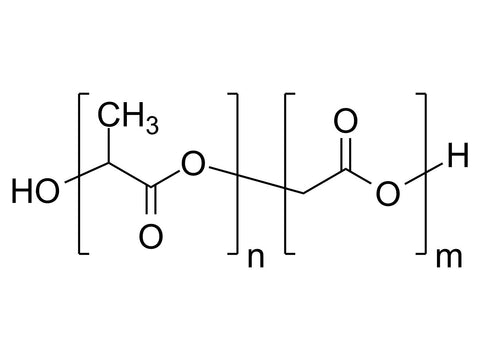
Polysciences Inc. Poly(Glycolide-Co-Lactide), 95:5, IV 1.7 dL/g
SKU: 50038-25
Polysciences Inc. Poly(Glycolide-Co-Lactide), 95:5, IV 1.7 dL/g
MSE Supplies offers polymer reagents from Polysciences Inc.
Product Overview
Poly(glycolide-co-lactide) (PGLA) is a biodegradable copolymer composed of glycolide and lactide monomers. Its physical and chemical properties can be tailored by adjusting the ratio of the two monomers with a higher glycolide content degrading faster and a higher lactide content degrading slower.
PGLA is widely used in medical applications, such as sutures, drug delivery systems, 3D printing, and tissue engineering, due to its excellent biocompatibility and controlled biodegradability. It is also used in the pharmaceutical industry as a biodegradable polymer matrix for drug delivery systems and in the food industry as a biodegradable packaging material.
PLG
Poly(lactic-co-glycolic acid)
Properties
References
1. Islam, M.S.; Mitra, S. Synthesis of Microwave Functionalized, Nanostructured Polylactic Co-Glycolic Acid (nfPLGA) for Incorporation into Hydrophobic Dexamethasone to Enhance Dissolution. Nanomaterials 2023, 13, 943. https://doi.org/10.3390/nano13050943
2. Serris, I., Serris, P., Frey, K.M. et al. Development of 3D-Printed Layered PLGA Films for Drug Delivery and Evaluation of Drug Release Behaviors. AAPS PharmSciTech 21, 256 (2020). https://doi.org/10.1208/s12249-020-01790-1
3. Middleton, John C., and Arthur J. Tipton. 2000. "Synthetic Biodegradable Polymers as Orthopedic Devices.” Biomaterials 21 (23): 2335–46. doi:10.1016/S0142-9612(00)00101-0.
4. Grayson, Amy C Richards, Insung S Choi, Betty M Tyler, Paul P Wang, Henry Brem, Michael J Cima, and Robert Langer. 2003. “Multi-Pulse Drug Delivery from a Resorbable Polymeric Microchip Device.” Nature Materials 2 (11). Nature Publishing Group: 767–72. doi:10.1038/nmat998.
5. Dawes, G J S, L E Fratila-Apachitei, K Mulia, I Apachitei, G-J Witkamp, and J Duszczyk. 2009. “Size Effect of PLGA Spheres on Drug Loading Efficiency and Release Profiles.” Journal of Materials Science: Materials in Medicine 20 (5). Springer: 1089–94. doi:10.1007/s10856-008-3666-0.
